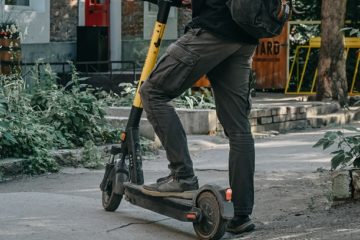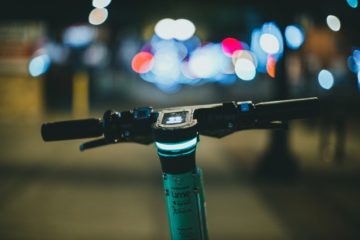Most electric scooters are not waterproof. Although it is possible to ride on a damp, slightly wet road, it is strongly recommended not to use it in rainy weather or to clean it with a water jet. And even less if it is under tension! But this rule is not always known and it can then happen that your electric scooter takes on water. In this case, discover the right reactions to adopt to avoid damaging your device. Then, find out if your electric scooter that has taken on water has already suffered damage.

What to do when your electric scooter has taken on water?
If water has got inside your electric scooter, measures must be taken to avoid irreversible damage to your device. Although the first instinct is often to want to turn the machine back on to check if it works, this is a serious mistake. So, without further ado, follow the troubleshooting guide below in order to avoid saying goodbye to your mobility device for good.
Turn off the scooter
La first thing to do when your electric scooter has taken on water is to turn it off immediately to avoid the dreaded short circuit.
Indeed, if there is no current and therefore no electricity in the electrical circuits, there is no risk of short-circuiting even if they are wet. On the other hand, when the current flows in the electrical circuit, the water can cause the phase wires and the neutral wires to meet when they should not. This is when the short circuit and irreversible damage to your device occurs.
Let the components of the electric scooter that has taken on water dry
After turning off the wet electric scooter, you will need to let it dry in a dry place at room temperature for several hours. If it is particularly wet or damp, dry the exterior of the scooter with a towel. Then it is better to wait at least 48 hours to be certain that there is no longer any presence of humidity in the electrical circuits and on the components. Obviously, this duration can vary depending on the amount of water that has entered your scooter. If the scooter has been completely submerged, it is advisable to let it dry for several days (at best 1 week). Do not attempt to turn it on or charge it until its components have dried thoroughly! This is essential if you want to avoid the short circuit and therefore the irreversible failure of the device.
If your scooter model allows it, open the battery compartment (which is often located at the level of the footrest) by removing the screws that hold it. Disconnect the battery power connector and allow the internal components to dry with the compartment open. This will allow the air to circulate better. Warning: some components store electricity: Use insulating gloves to avoid the risk of electrocution.
Warning, it is not recommended to use a hair dryer to dry your electric scooter that has taken on water more quickly. You run the risk of displacing the water inside the components or electrical circuits, in places that take longer to dry and therefore cause the failure when the device is powered up.
If corrosion is visible after it is completely dry, you can scrub the contacts very gently with a new, dry, soft-bristled toothbrush or a soft, dry, lint-free cloth.
Important: If you want to clean or dust your electric scooter, refer to the user manual for your model. Never clean the electrical circuits or the battery with water, detergent or any other liquid. Use a dry cloth. In the event of oxidation or encrusted fouling, use a compressed air spray suitable for electronic components.
Check the waterproof level of the electric scooter
Also note that the degree of waterproofness of the scooters is not the same depending on the model. Some scooters are more or less waterproof. So, if you have a water-resistant electric scooter model, chances are that its components are safe from drops or moisture.
To find out if your electric scooter model is waterproof or not, a international protection index (IP) was established. You should then see on your scooter or on its user manual IP *followed by two numbers*. The first number, which can range from 0 to 6, indicates the level of protection against the intrusion of solid bodies (dust, debris, dirt, etc.) into the scooter. The second number, this time on a scale ranging from 0 to 9, indicates the level of protection against liquids and therefore against the intrusion of water into the scooter. The higher the number, the greater the protection.. An electric scooter that would have an IP69 protection index would therefore have the highest sealing standard. However, from the number 7, you can consider the scooter to be waterproof. Note: If no protection criteria exists, the number is replaced by an X.
Most electric scooters have a IP54, which means that they are resistant to dust and residues invisible to the naked eye and that they can withstand low pressure water splashes from all directions. In other words, they can drive in light rain for a few minutes but they cannot be submerged. Watch out for puddles and torrential rain!
La Xiaomi m365 scooter, probably the best selling scooter, first generation is not waterproof. Its replacements, the Xiaomi Essential, 1S and Pro 2 electric scooters do have the IP54 standard (be careful, however, of counterfeits). They can therefore be used in case of rain, but once again, it is not advisable to immerse it and therefore avoid puddles and use it in case of severe weather.
What to do if the electric scooter that has taken on water no longer turns on?
Si your electric scooter that has taken on water is experiencing malfunctions or that it no longer turns on, unfortunately the damage is done and a component has suffered damage. Depending on the type of breakdown you encounter, it may be more or less repairable. Indeed, it can be the battery, the controller, the display, the On/Off button, a connector or even the motor. As you will have understood, all the electrical components of the scooter can be affected and this is what makes the diagnosis particularly difficult to perform.
As a first step and if it is not already done, try to let your electric scooter dry for 1 week, disconnecting the battery power supply. Then try reconnecting the battery, charging it and turning the scooter back on.
If it still does not work, we advise you at this stage to call a professional so that he can identify the problem and fix it efficiently. Unfortunately, even if your scooter is still covered by the legal guarantee of conformity, oxidation, and therefore breakdowns related to water, is not covered by the guarantee.
Before contacting a professional, you can also try to perform the different manipulations below if you have some electrical clearances:
Testing and replacing the electric scooter battery
Generally if your electric scooter that has taken on water does not light up, the problem comes from the car's battery performance. Indeed, it is the most fragile element of the scooter. Often placed at the level of the footrest, it is directly exposed to splashes of water even though it is not waterproof. This is why it is so important to avoid riding in puddles of water because even temporary immersion in it can irreversibly damage your battery.
1 – Test the battery
To check if the battery is the component that failed after your electric scooter got wet, here's how to test it (test adapted to a lithium-ion battery) :
Note: The battery is almost always in the tray (footrest) Or in the frame of the device. Refer to the user manual for your scooter model to find the location of the battery, as well as all the necessary information on its characteristics (and in particular its voltage).
- Switch off the scooter and wear insulating gloves throughout the handling to avoid the risk of electrocution. Wait for the scooter to dry well (1 week in case of complete immersion of the battery).
- Remove the footrest to get to the battery.
- Disconnect the battery power supply and check that there are no traces of water or humidity.
- If there are no traces of water, measure the battery voltage. To do this, set the multimeter to the voltmeter position (200V). Put the two test probes of your multimeter on the battery power cables.
The measured voltage should be approximately the same as your battery voltage. Generally, the voltage of electric scooter batteries is between 36V and 42V. To be confirmed with regard to yours by consulting the instructions or the voltage indicated on the battery. If the voltage is out of specification (either lower than battery voltage or zero), the battery is faulty. It will therefore have to be replaced.
2 - Replace the battery
If the battery of your scooter that has taken on water is faulty, the only way to fix the problem will be to replace. This manipulation is relatively simple since you just have to remove the old battery by removing the screws and connectors, and reconnect the new battery in the same way. Of course, this manipulation is done off.
To avoid affecting the performance or life of your device and for your safety, replace it with a quality battery, if possible from the same brand. Indeed, each battery model has its own characteristics (different voltage and power). Your scooter is therefore designed for a certain type of battery. If you use an incompatible battery with the charger (not the same voltage and not the same power), there is a risk of damaging the battery and your scooter.
To be certain of compatibility, it is therefore better to equivalent battery. You will find the battery on online merchant sites by typing the reference of your scooter model and/or the battery. In all cases, choose a compatible battery, i.e. of the same size and the same charge intensity. Avoid at all costs counterfeits that do not have all the required safety standards and certifications.
Note that there may also be other components in addition to the battery that have taken on water and are faulty (connectors and motherboard in particular). In this case, simply replacing the battery will not be enough to solve the problem.
3 – Protect the battery from water and humidity
To secure your next battery and prevent water infiltration, we advise you to reinforce the exterior assembly of the battery compartment and therefore of the footrest. To do this, you can simply use a silicone shower seal to affix to the edges of the tray. Refer to a video tutorial on the net to do it properly. Be careful not to put too much of it to allow you to always be able to access the battery or other internal components.
Note that for some scooter models (especially for Xiaomi's M365 model), there are seals easy to install and remove if needed.
Check for oxidation traces on the motherboard and the display board
If your electric scooter that has taken on water starts to malfunction, there is a good chance that the problem comes from the controller (or motherboard). It may be that his circuit board is oxidized. To check this, you need to access the controller of your electric scooter (usually it is located next to the battery), then see if you see any oxidation or corrosion (white or brown marks). If so, you will need deoxidize the map or ask a professional repairer to do so.
If the handlebars of your electric scooter have taken on water, and there is no longer any display, carry out the same checks with the display card. That is to say, you will have to remove the screen and visually check if the display card seems damaged (traces of water or oxidation). Then test the voltage of the display board using a multimeter set to voltmeter. If it is defective, replace it with a new equivalent.
Contact a professional repairer
If unfortunately you are unable to identify the origin of the breakdown, you will need call a professional so that he can carry out a more precise diagnosis on the extent of the damage and thus tell you if the repair is worth the cost or not. Note that the warranty does not cover water damage, the repair costs will unfortunately be entirely your responsibility.


0 Comments